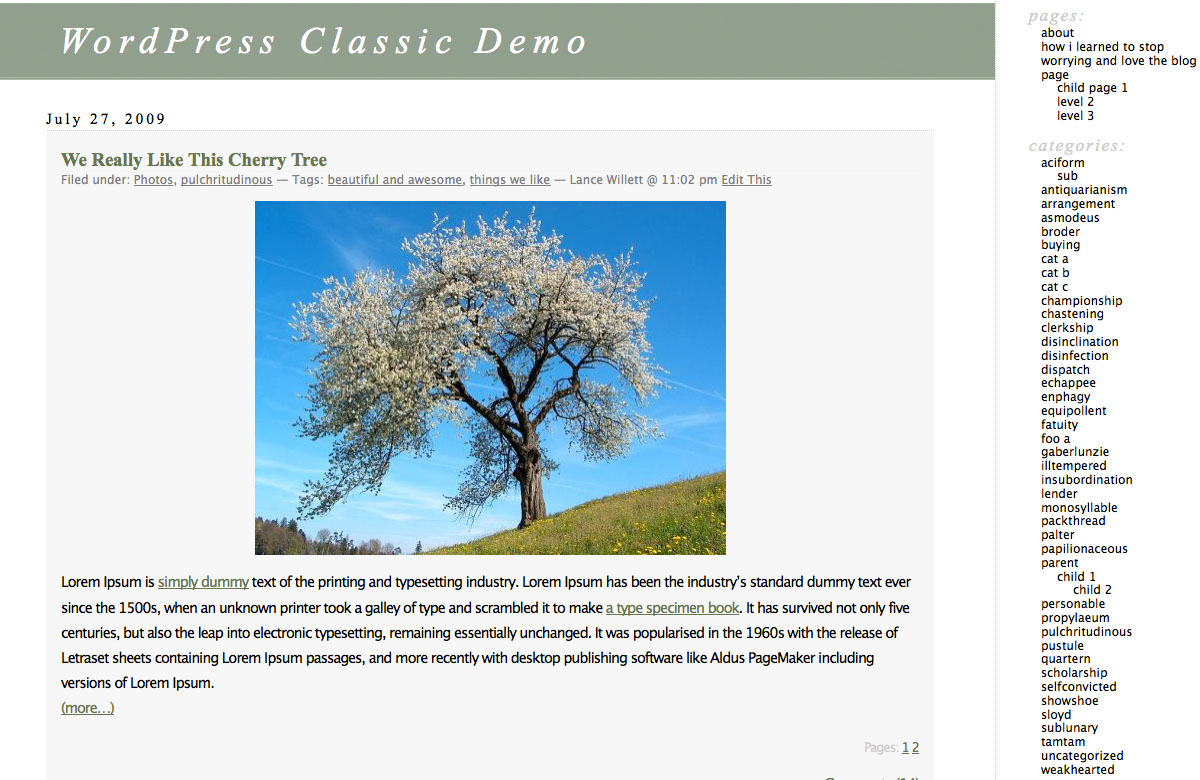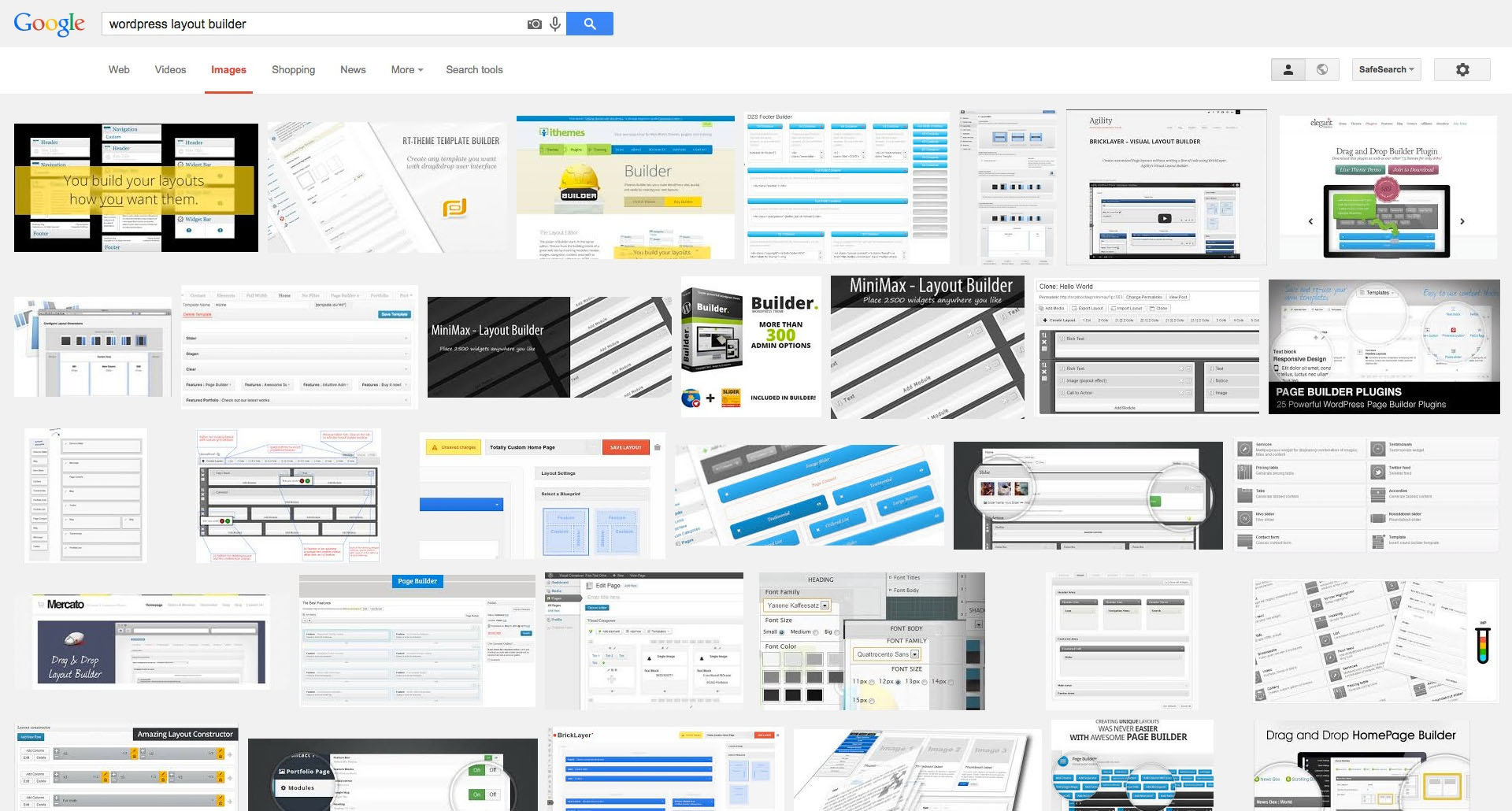Ok people, it’s rant time. WordPress themes suck. That’s nothing new, but this time they suck because they’ve gotten so good. WordPress themes 2015 state of affairs is a bipolar mix of exceeding limitations and overstepping boundaries. It’s time we reeled ourselves back in.

On the one hand, no WordPress user could have imagined back in 2005 what today’s themes are capable of. Form and function are so far above and beyond their origin that they’re unrecognizable to their predecessors. On the other hand, the wild west of hackery used to shoehorn these futuristic themes into a simplistic publishing platform is killing the industry.
[stripe html_class=”light-grey”]Good: How far we’ve come.
Who remembers being sick of Classic and rejoicing when Kubrick came out? Let’s pause to appreciate that. There was a time when this was new and awesome. That was the best the WordPress world had to offer at the time—2006, I think? How far we’ve come.
The same could be said, of course, for the web in general. WordPress may have played a tiny part in advancing the standard of web interfaces, but that didn’t start right away. In the mid-2000’s, for those who’ve been in the game that long, the web was a barely-navigable nightmare of IE6, tables, and Times New Roman. And WordPress was mostly just along for the ride. There was very little leadership from major players. How far we’ve come there too.
I had a history teacher in high school who used to remind his classes frequently that the past can’t be judged through a contemporary lens. It’s classic cognitive bias and it’s nearly impossible to avoid. This is the reason different generations feel differently about the past. Some can remember a time before the polio vaccine. Some can’t. Some have personal experiences to draw on to shape their opinions. Some don’t. But I digress.
WordPress themes 2005 can’t be judged through a 2015 lens. All we can do now is compare 10 years of progress to its roots and marvel at the changes. Themes (Theme? Were there any other options? I can’t remember) back then had almost no flexibility of any kind. No “Theme Options” admin screen. No “Customize” Appearance tab. You were lucky if you could swap out your header. And, if my memory & understanding of the industry serve, it wasn’t until about 2007 or 2008 that authors started to use WordPress as a full CMS. Until then it was just for blogging. No one needed any additional functionality.
Bad: How far we’ve strayed.
WordPress wasn’t meant to be a CMS. Its codebase isn’t written to support that behavior. Therefore, things like layout builder plugins are the best WordPress developers can do. If authors want to control their page layouts, and WP has no native method for that, what’s a developer to do? Oh right, write a page builder plugin or theme add-on.
But do we really need that? Does WordPress really need to be added onto and plugged into and extended until it’s bursting at the seams? Are we sure that’s good for us and the platform?
I can’t be the only WP dev who’s tired of deciphering new layout builders with each new theme I encounter. ThemeForest shares some culpability here. Ever tried to submit a theme to their marketplace? It will be quickly rejected if it doesn’t have all sorts of bells and whistles. To their credit, they did make a big push a while back to separate out themes and plugins for functionality. And that was a step in the right direction, but the ThemeForest culture was already in place—the fancier the better, with no regard for consistency or stability.
It’s as if everyone’s trying to win the WordPress theme war. We’re all concerned with my way that we’re losing sight of the right way.
[stripe html_class=”light-grey”]Next: What to do about it.
Automattic has solved this problem twice before. In its earliest form, WordPress didn’t provide the easy ways for authors to extend display and functionality that we enjoy today—custom themes and plugins. The next frontier of WordPress core functionality should be layouts.
Hundreds of pioneering developers have already proven the layout builder concept. Now it’s up to WordPress to standardize it. This would give them control over code standards and admin interface. But, more than that, it would give them editorial review of user-generated layout add-ons again.
Yes, to some extent they have this already if themes or plugins are published in the WordPress repo, but many of them aren’t. And the ones that are only have to meet a bare minimum of security and timeliness standards. As far as I know, there are no PHP code standards or admin interface rules.
If Automattic took over layout building, the wild west of themes and plugins vying for the top spot would all immediately take a back seat. And that would be a good thing.



Couldn’t agree more! Most themes today are bloated with things we don’t need or can easily add with a plugin. Nice post!
I agree that most commercial WordPress themes (especially on themeforest) are bloated and overcomplicated, but I don’t think layout builders are the next obvious step. I think there is something to be said for maintaining seperation between the content creators and the designer. Typically, clients that I hand off WordPress site’s to manage are not designers. A layout builder in the hands of an office manager could spell disaster for a website. Even if it’s easy to use and standardized.
I think WordPress needs to focus on flexible content types (custom meta fields, post types, etc.) that designers can use to compartmentalize content so it can easily be managed and maintained by non-designers. Every single one of the new WordPress features that allow you customize the *design* of a site are wasted IMO. Then again, I belong to a specific subset of developers, while WordPress caters (very heavily) to non-technical folks wanting to build a website without hiring a techy…
Thanks for your comment, Casey. And I’ll admit that your suggestion gave me pause. Separating out the content and display is important. And I agree that WP caters to non-technical folks. But in the meantime, while authors are still creating layouts for themselves, I’m hoping for a way to standardize the method. I hope WP will reel in the wild west of layout builder junk and set a few rules along the way.
I agree with the diagnosis, but not the treatment. I think the trend is already being corrected. The rise of bespoke themes designed fit-for-purpose/medium provides a better model to follow. Once you’ve got a solid framework to rapidly develop themes (and luckily now there’s some good lighter weight ones available), it makes more sense to strip back the flexibility (and bloat) to instead provide a greater variety of themes, each with a solid design for their desired purpose and/or audience.
I don’t think WordPress needs to standardise the layout builder approach, because its the wrong approach. The bloat is unavoidable, they’d just be adding it to core. Selectable page templates, custom sidebars and widgets can do everything that’s required if the theme is styled correctly and for more advanced cases, you have code, and there isn’t a more simple templating system on any other platform.
Wordpress has come a long way to server the CMS market, but it shouldn’t try to be all things to all people.
I’ve also just started ranting on my approach to this problem re theme frameworks and starter themes: https://medium.com/wordpress-continued/the-story-so-far-c43339b7d007
p.s. If you’re just interested in the relevant section, you can skip the first half to avoid my sob story.
Tim.